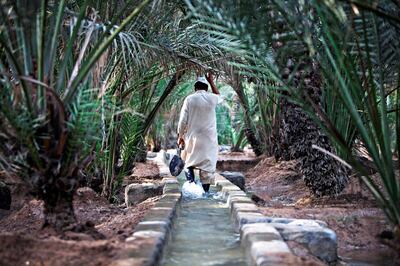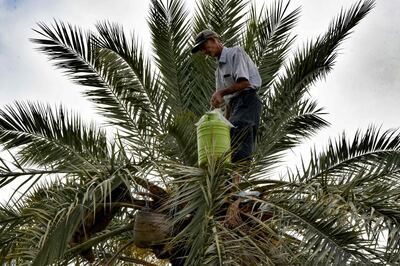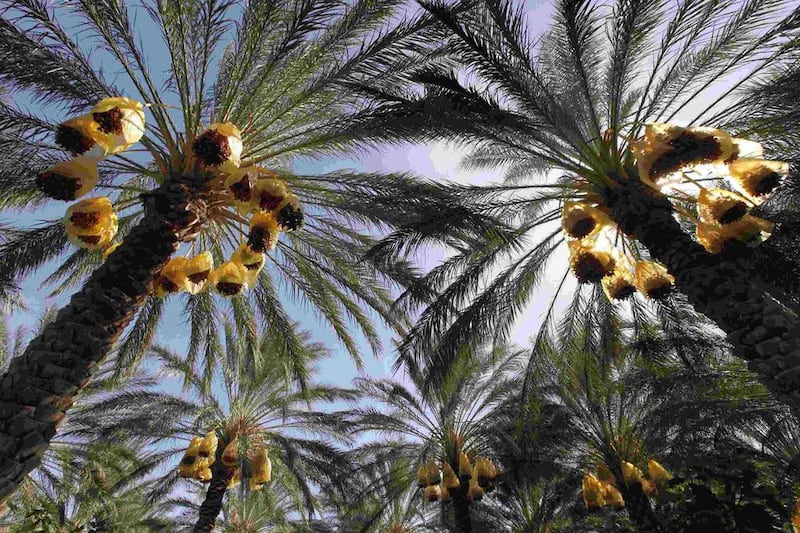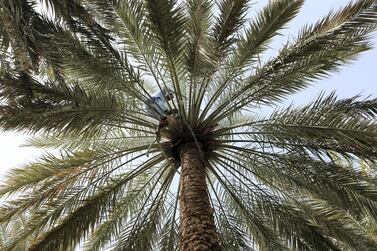Date palm cultivation is a story as old as civilisation. The Ancient Egyptians embossed them on amulets, the Romans incorporated them in mosaics and the Mesopotamians painted them on vases.
Yet until recently the genetic make-up of the species had never been extensively mapped, a success largely attributable to geneticists at New York University Abu Dhabi (NYUAD).
For nearly eight years, an international team of scientists has been hard at work meticulously recording its significant genetic variations.
Seed and plant samples have been collected from Pakistan to Libya, all in an effort to accurately map its genome and ensure enough is known about the plant that it can be protected from pests, secured against a changing climate and even improved in taste.
“For the last few years, what we’ve been interested in doing is to try to map genes in date palms that might be important, for key traits in fruits especially,” said Michael Purugganan, the geneticist who leads NYUAD’s Centre for Genomics and Systems Biology.
“The climate is changing and we don’t know what’s going to happen in terms of date palm agriculture.
“The land that’s being used for date palms is rapidly deteriorating. How do we deal with deteriorating land issues? How do we face different diseases and pathogens and pests?”

The groundbreaking UAE study of the slow-growing, hardy desert plant has presented a unique set of challenges to researchers.
Most crop species, such as corn or wheat, have an international seed repository but dates do not.
There are at least 3,000 named varieties of date palms and NYUAD first had to build its own collection, approaching colleagues from around the world.
But word soon spread and their database grew. One geneticist even couriered dates from Damascus to the Emirates at the beginning of the Syrian civil war.
North African and Middle Eastern date palms are known to be the same species but are genetically different.
One theory was that the tree evolved twice, once in North Africa and once in the Middle East.
The oldest archaeological date palm records in the Gulf are two date stones from Abu Dhabi’s Delma Island, dated between 6,600 to 7,100 years old. Nothing shows up in North African records for another 4,000 years.
Given the time gap, scientists had another theory: maybe dates were like apples. Prof Purugganan explained: “The original apple came from Kazakhstan but when it got to Europe it hybridised with the European crab apple and that gave us the modern apple.”
Support for this theory came out of the blue from Oman in 2017.
There, a French geneticist was on her own search for the wild date palm. But dates were so widely cultivated for millennia, it was impossible to find palms that hadn’t descended from farmed populations.
“You can find uncultivated palms everywhere, in the Sahara, in the Sinai, in the Dead Sea region, in the Zagros Mountains,” said Muriel Gros-Balthazard, who later joined the NYUAD lab.
“The issue is you don’t know if they are truly wild populations or feral.”
Dr Gros-Balthazard got a break when colleagues in Oman presented her with small, round date seeds from the Hajjar mountains.
The shape was promising. Older species of olives and grapes also have rounder seeds. When the DNA was analysed, they proved to be wild and evidence the palm likely originated in the Arabian Peninsula.
“Right now we are really interested in trying to understand what the wild relatives of the date palms are doing,” said Professor Purugganan.
“We’re in the process of really looking carefully at those other wild species that are closely related because in the future if we wanted to improve date palms, we can get genes from these other species and help them adapt to different environments.
“The population of the world is going to hit 9.7 billion by 2050. In every food species, we’ve got to be able to increase productivity.”
By early 2019, researchers had established that the North African date palm had originated from a palm found mainly on Crete, in the eastern Mediterranean.
Last week, the team announced another significant breakthrough: they had succeeded in identifying the date palm genes for colour and sugar production.
The traits were found in a new genome sequence of 772 million base pairs, the basic building blocks of DNA. It is longest piece of the date palm genome sequence that has ever been read.
The research, done in partnership with UAE University and the University of Arizona, was published in the peer-reviewed journal Nature Communications.
The technique used in this study, called genome-wide association study, is already being used on other date varieties, including the famed black Ajwa dates of Medina, a favourite snack of the Prophet Mohammed.

“You really learn about the history of life by understanding these genomes,” said Rod Wing, director of the Centre for Desert Agriculture at King Abdullah University of Science and Technology in Saudi Arabia, and one of the researchers on the project.
“It’s in there, you’ve just got to know how to look for it. We’re in a place now where we can do this and the Middle East is opening up to more investigations and there are lots of opportunities.”
And so it seems that major advances in the accuracy and affordability of genome mapping, as well as increased Gulf funding and a heightened global demand for crops that can withstand drought, have combined to enhance the study of the date palm.
As Khaled Al Amiri, director of the Khalifa Center for Genetic Engineering and Biotechnology at UAE University, explained, the date palm - to date - has been overlooked. But this is now changing.
“We are living in the desert and climate change is coming up on us so we need to develop plants that are amiable to living in harsh conditions,” he said.
“The date palm is considered an orphan plant because there’s not much research on it.
“We want to make those resources. We want to make this plant as prominent as apples, peaches."






